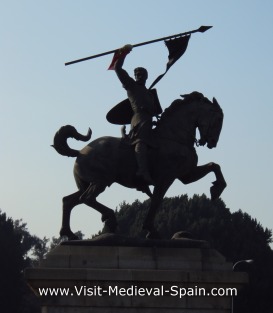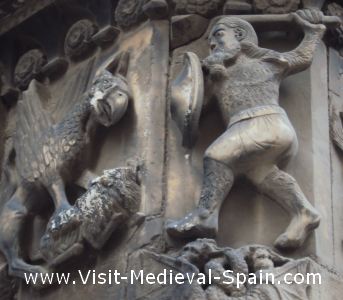SPANISH HEROES AND LEGENDS
The Legend of El Cid
Rodrigo Diaz Vivar (1040 - 1099) - "El Cid Campeador".
The Legend of El Cid has been told in many forms since the 12th century A.D. He is a Spanish national hero, probably the best known outside Spain - Largely due to the 1961 Hollywood movie in which he was played by Charlton Heston.
Born near Burgos (the Castillian Capital) he first served as a general under Sancho II up until the king was murdered. Suspicion fell upon his successor King Alfonso VI and according to the legends El Cid made him swear an oath that he had nothing to do with the assassination of his brother.
Sancho II up until the king was murdered. Suspicion fell upon his successor King Alfonso VI and according to the legends El Cid made him swear an oath that he had nothing to do with the assassination of his brother.
El Cid was later forced into exile and became a mercenary at the head of his own combined Christian / Muslim army and even fought for the Moors before being recalled to fight for a now threatened King Alfonso.
It was around this time that his army reconquered Valencia and the surrounding towns in the name of King Alfonso. He then governed the city up until his death in 1099.
The Legend of Guzman "The Good"
Alonso Perez de Guzmán (1255 - 1309)
Another hero of the Spanish "Reconquista" Alonso Perez de Guzmán was the illegitimate son of a minor Castilian Noble . He left Castile after arguments with his brothers and , like El Cid,became a mercenary fighting for both the Christians and the Moors in Spain and North Africa, where he earned the reputation of being a great warrior.
In 1294 King Sancho IV put him in charge of the town of Tarifa , recently recovered from the Moors. Shortly after this the town was besieged by Moorish troops under Ibn Yaqub. The town was totally cut off and awaiting the arrival of Aragonese reinforcements by sea when Guzman's son and heir was taken hostage.
The Moorish leader told Guzman that if he didn't surrender the town then he would cut his son's throat. To which Guzman replied by throwing him his dagger and saying:
"I did not beget a son to be made use of against my country, but that he should serve her against her foes"
Thus, his son was killed but the town saved and Alonso Perez de Guzman became known as Guzman "The Good". Later, after successfully defending Gibraltar, he became Duke of Medina Sidonaia (near Malaga) and continued fighting against the Moors up until his death in 1309.
The legend of Wilfred "The Hairy"
Guifre "el Pilós" ( ? - 897)
Although the year of his birth is unknown Wilfred "The Hairy" was of Hispanofranco descent and son of Sunifred of Urgel. He became Count of Urgel and Cerdenyá and in 877 was named Count of Barcelona, Besalú and Girona by French King Charles "The Bald" as reward for his services. Wilfred worked to repopulate and link the 5 counties and built fortifications in towns as far South as the River Llobregat.

This strengthening of his territories caused the Moors to fortify Lleida. Wilfred in turn saw this as a direct threat and led a failed attack on the city which in turn provoked the Moors into attacking Barcelona. When Wilfred died in battle defending Barcelona against the Moors in 897 A.D. his titles passed to his son.
Legend has it that the Catalan flag has its origins in the coat of arms presented to Wilfred by Charles the Bald as a reward for his bravery after he was injured in battle. According to the legend the King visited Wilfred in his tent where he lay bleeding, wet his fingers with Wilfred's blood and traced four lines across the injured Count's golden shield.
Whether or not the legend is true the design was used as the coat of arms of Aragon .Today it forms the basis of the flags of the 4 Autonomous Comunities which made up the Kingdom of Aragon; Aragon, Catalonia, Valencia and the Balearic Islands.
The Legend of Don Pelayo
Don Pelayo ( ? - 737)
The exact date and place of Don Pelayo's birth is unclear. According to the legends he was the son of a Visigoth noble who was killed fighting against Witiza in the battles of the Visigoth Clans. After the death of his father, Pelayo went on a pilgrimage to Jerusalem before returning to Spain to fight for King Roderick (The last Visigoth King of Spain). Pelayo was member of the Royal Guard up until the battle of Guadalete when Spain was taken by the Moors in 711 A.D.
When the Moors conquered Spain, Pelayo and many of the Spanish troops fled north and continued fighting in the mountainous regions of Cantabria and Asturias. Don Pelayo finally fell into the hands of the Moors and was sent to Cordoba as a hostage/envoy. Meanwhile his sister Adosinda was forced to marry Munza the Moorish Governor of Gijon. Supposedly this is what spurred Don Pelayo to escape his captors and return to the mountains near Covadonga to fight in what became the Christian "Reconquista" of Spain which started in 718 and lasted nearly 800 years.
Many of the Visigoth/Christian Nobles lived very comfortably under Muslim rule and where reluctant to join Pelayo's troops in their heroic struggle. The Spanish forces where greatly outnumbered but Pelayo and his knights finally beat Al Quaema's army at the battle of Covadonga in 722 when he became the first King of the Spanish Kingdom of Asturias.
King James I "the Conquerer"
James I of Aragon (1208 - 1276)
James the first of Aragon was another hero of the Spanish "Reconquista". Born in Montpelier in 1208, he ascended to the throne at the age of six when his father,
Pedro II "The Catholic", was killed in the battle of Muret. After his father's death the young King was taken hostage until the Pope ordered that he should be returned to his family.
He was then taken into the custody of the Knights Templar in their castle at Monzón.
There then followed a period of ten years of anarchy and revolt as his Uncle tried unsuccessfully to control the kingdom's nobility. Finally in 1225, at the age of 17, King James I returned to take control of his kingdom.
The Young King spent the first few years of his rule regaining control of the rebellious nobles with fierce battles at Albarracin and Montcada. In 1229, with his kingdom back under control and more powerful than ever, James I set out to regain Mallorca from the Moors. It was this famous victory that earned him the title of "the Conqueror" ("El Conquistador" in Spanish). By the time of his death in 1276 King James's kingdom had expanded to include Aragon, Catalonia, all four of the Balearic Islands and Valencia.
Christopher Columbus
Born Genoa 1451 - Died Spain 1506
Over the years, historians have speculated over Columbus' nationality. There have been claims that he was: Genoese, Italian, Spanish, Portuguese, Catalan, Greek and even Polish. However, it is generally agreed that he was born in Liguria in Genoa (now Northern Italy) in 1451.
There is also the question as to whether he really discovered the Americas. Firstly there is the fact that the Nordic explorer Leif Ericson is supposed to have landed in Newfoundland early in the eleventh century. Secondly the minor detail that there were already people living there! To top it all off, Columbus himself claimed that he had discovered a westerly route to the East Indies! He had set out to find a new and faster trade route between Europe and Japan - An idea that he had previously attempted to sell to the Portuguese before finally getting support from the Spanish Catholic Monarchs (Ferdinand and Isabella).
These small details aside, Christopher Columbus claimed the Americas for the Spanish Crown when he landed in San Salvador (now in the Bahamas) on the twelfth of October 1492. Upon returning to Spain he was appointed Viceroy and Governor of the Indies and during 3 subsequent voyages discovered more of Central America and Venezuela. Unfortunately for him, he didn't find the Aztec and Inca riches which were to have such a profound effect on the future of Spain. In fact, after his fourth voyage it seems that he fell out of favor in Spain. He was stripped of his titles, spent some time in prison and his once generous patrons finally refused to pay him and his heirs the riches that he had been promised - He had originally been promised ten percent of all revenues from the "new lands" !
The Legend of the Lady of Arintero
Juana Garcia de Arintero (Legendary heroine from Medieval Spain)
In 1474 at the onset of the Spanish War of Succession, the Catholic Monarchs decreed that every household which included males between 18 and 35 years of age should send one of them as a volunteer to fight against the Portuguese army. In the Leones village of Arintiero Count Don Garcia of Arinterro became very depressed because he was too old to fight and had no sons to take his place. On seeing her father so distressed Juana, the fourth of his 7 daughters, decided to cut her hair and dress as a man in order to fight. So it was that after 2 months of training, dressed in armour and on horseback, Juana Garcia de Arintero set off to fight against the Portuguese.
According to the legends, after months of arduous fighting on the frontline Juana de Arintero, using the title of Knight of Oliveros in order to hide her true identity, became renowned as a valiant and heroic knight. In 1475 in the midst of the Battle of Toro, Juana clashed lances with a Portuguese knight. The impact was such that it ripped open her armour revealing one of her breasts. The other Spanish knights were stunned to find that the heroic warrior fighting along side them was in fact a woman. Once the Portuguese had been defeated, the Lady of Antiero was presented to King Ferdinand II who rewarded Juana by conceding her a series of titles and rights in recognition of her bravery. The details were written in an official document signed by the King which Juana carried with her as she returned to her village.
When Queen Isabella heard of this she became very jealous and sent a group of soldiers after the Lady of Arintero with orders to retrieve the document. As she neared her village Juana spent the night in the house of family members in La Candana. She told them of the honours bestowed on the family by the King but at the same time she heard that there was a group of soldiers perusing her. Juana entrusted the document to her cousin who she told to take it to her father and prepared herself to confront the soldiers.
Depending on which version of the legend you hear, the heroic Lady of Arintero either died fighting the Queen's soldiers or survived to marry an Asturian Lord.